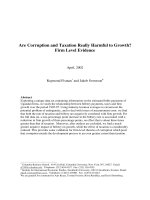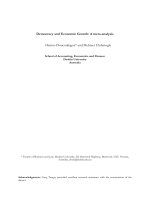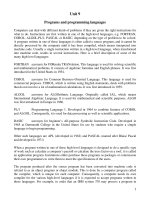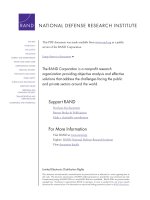Why Some Cities Are Growing and Others Shrinking pdf
Bạn đang xem bản rút gọn của tài liệu. Xem và tải ngay bản đầy đủ của tài liệu tại đây (106.31 KB, 20 trang )
Why Some Cities Are Growing and
Others Shrinking
Dean Stansel
Over the last three decades, large cities like Pittsburgh, Detroit,
Cleveland, Buffalo, and Toledo have seen their populations shrink,
while areas like Houston, Atlanta, Dallas, Tampa, and Phoenix have
seen their populations grow rapidly. Examining the policy differences between high-growth and low-growth areas can provide evidence that may help declining cities reverse their fortunes.
In 1980, Austin, Texas, and Syracuse, New York, were roughly
the same size. The Austin metro area had a population of about
590,000, and the Syracuse metro area had about 643,000 residents.
By 2007, Austin’s population had increased by more than 1 million
while Syracuse’s population had been stagnant. That same disparity
exists when one examines the growth of employment and real personal income. Another disparity between the two areas is the tax
burden. State and local taxes accounted for nearly 13 percent of
personal income in Syracuse but only about 9 percent in Austin.
Although there are numerous factors that can influence the growth
of individual economies, one finds a consistent relationship
between low taxes and high economic growth in metropolitan
areas, in states, and in nations.
This article details that relationship between taxes and growth for
the 100 largest U.S. metropolitan areas. In the 10 highest-tax metro
areas, the state and local tax burden accounted for about 12.4 percent
of personal income. In those same areas, population grew by
Cato Journal, Vol. 31, No. 2 (Spring/Summer 2011). Copyright © Cato Institute.
All rights reserved.
Dean Stansel is an Associate Professor of Economics in the Lutgert College of
Business at Florida Gulf Coast University in Fort Myers. He thanks Edward J.
Lopez, Jeff Noble, and an anonymous referee for useful suggestions.
285
Cato Journal
21.3 percent from 1980 to 2007, employment grew by 40.1 percent,
and real personal income grew by 75.5 percent. In contrast, taxes
were only 8.3 percent of personal income in the 10 lowest-tax areas.
The economic growth in those areas was much faster. Population
grew by 64.4 percent, employment by 107.6 percent, and real personal income by 157.3 percent.
The contrasting experiences of Austin and Syracuse occurred in
countless other areas as well. This article provides 14 additional
examples of pairs of metro areas that had similar tax and growth
patterns.1 The experiences of all 15 pairs of metropolitan areas
provide valuable lessons for distressed areas everywhere. Keeping
tax burdens low appears to be an important ingredient in the
recipe for economic prosperity. If high-tax, low-growth metro
areas like Detroit, Milwaukee, Buffalo, and Syracuse want to be
more like high-growth areas such as Dallas, Tampa, San Antonio,
and Austin, they should lower their onerous burden of taxation and
bring spending under control.
Taxes, Economic Growth, and Prosperity
In 1776, Adam Smith wrote An Inquiry into the Nature and
Causes of the Wealth of Nations. Economists have been busily examining the issue ever since. It is one of the most widely studied topics
in the field of economics. One of the most common findings relates
to how economic activity is organized. For example, capitalist countries (those in which economic activity occurs on the basis of voluntary exchange within private markets) tend to grow faster than
socialist countries (those in which economic activity is organized by
government). The existence of private property rights in capitalist
countries helps create stronger incentives for individuals to be productive. As a result, factors of production (including labor and capital) tend to flow out of socialist countries and into capitalist countries.
The economic collapse of the Soviet Union and other bastions of
socialism provide ample evidence of that.
1
These correlations do not prove that low taxes have caused the economic growth.
There are many other factors that have an important influence on economic growth.
For example, Walters (2010) provided evidence of the negative relationship
between unionization of the local labor market and city growth. Incorporating those
factors is beyond the scope of this article. See Stansel and Swaleheen (2010) and the
additional articles by myself and others cited in footnotes 3 and 4 for articles that do
take account of other factors.
286
Why Some Cities Are Growing
Starting in the 1980s, Nobel economist Milton Friedman played
an important role, along with many other economists and public policy experts, in the development of an index of economic freedom that
would allow researchers to be able to measure the degree to which a
country had a free market economy. Those efforts culminated in the
Fraser Institute’s publication in 1996 of the first edition of Economic
Freedom of the World. There have been 14 more editions published
since then in what is now an annual series. Large volumes of research
have illustrated a positive relationship between economic freedom at
the national level and economic growth. One of the problems for
economists examining that relationship is that there are many other
factors that can influence growth, and those factors can vary widely
across a broad selection of nations. For example, there are large differences in religion, cultural, and other institutional factors. Those
types of factors are very difficult to quantify, thus our ability to
account for their influence on the process is quite limited.
One way to avoid that problem is to look at sub-national jurisdictions. For example, the 50 U.S. states have much less variation in religion and culture than do two nations such as the United States and
China. In 2002, the Fraser Institute produced its first edition of the
Economic Freedom of North America, which provided an index of
economic freedom in U.S. states and Canadian provinces (see
Karabegoviỗ and McMahon 2008).2 Because smaller jurisdictions
share a more common set of cultural institutions, it is easier for
researchers to accurately examine the relationship between economic freedom and economic growth. There is growing evidence
that states with higher economic freedom and lower taxes are more
prosperous, even when the effects of many other growth-related
factors are incorporated.3
Examining states addresses some of the challenges inherent in
using national data, but not all of them. The boundaries of states
and provinces are relatively arbitrary and some local economies
cross them. For example, the Washington, D.C., metropolitan
2
In addition, the Pacific Research Institute has produced a state-level index, U. S.
Economic Freedom Index (McQuillan, Huang, and McCormick 2004), and in 2009
the Mercatus Institute produced a broader state index, Freedom in the 50 States:
An Index of Personal and Economic Freedom (Sorens and Roger 2009).
3
See, for example, Vedder (1990), Bartik (1991), Becsi (1996), Wasylenko (1997),
Crain and Lee (1999), Kreft and Sobel (2005), Ashby (2007), Campbell and
Rogers (2007), Ashby and Sobel (2008), Hall and Sobel (2008), Reed (2008).
287
Cato Journal
area includes counties in Maryland, Virginia, and West Virginia.
There are more than 30 other metro areas that cross state boundaries and a few cross national boundaries. San Diego’s metro area
is on the U.S.-Mexican border, while Buffalo’s is on the U.S.Canadian border. Furthermore, economic conditions can vary
widely within those boundaries. Conditions in Dallas’s metro area
are quite different from those in the Lubbock and Amarillo metro
areas a few hours to the west. Using the local economy as the unit
of analysis helps to address the problems related to using nations
or states. In the United States, the metropolitan area is a countybased concept designed to reflect the boundaries of local labor
markets or local economies.
Although there is no economic freedom index for metropolitan
areas, there are data available on taxes and spending. One of the most
important components of the various economic freedom indices is
the tax burden. Taxes remove resources from private decisionmakers and put them in the hands of elected officials and bureaucrats. The latter face much weaker incentives to use those resources
efficiently and lack the information to be able to do so. As a result,
jurisdictions with higher tax burdens will tend to have less prosperous economies. Furthermore, high-tax areas will tend to be less
attractive to residents and businesses. Because people and employers are mobile, high taxes will discourage in-migration and encourage
out-migration. The literature examining local jurisdictions is limited.
However, there is growing evidence that localities with higher
taxes—and larger government in general—have less prosperous
economies, even when the effects of many other growth-related factors are incorporated.4
Taxes and Economic Growth in the 100 Largest U.S.
Metropolitan Areas
To test the hypothesis that high-tax areas have less prosperous
economies, one can observe data on taxes and economic growth for
the 100 largest metro areas in the United States—that is, those with
2007 populations over 575,000—during the last three decades. The
4
See, for example, Bradbury, Downs, and Small (1982); Dalenberg and Partridge
(1995); Crihfield and Panggabean (1995); Holcombe and Lacombe (2004);
Higgins, Levy, and Young (2006); Stansel, Gohmann, and Hobbs (2008); Stansel
(2009); and Stansel and Swaleheen (2010).
288
Why Some Cities Are Growing
tax data measure total state and local taxes as a percentage of personal income. The local tax data are collected by the U.S. Census
Bureau’s Census of Governments every five years. The state average
is then added to the local figure to provide for more valid comparisons across states.5 To track changes in the tax burden over time, we
can take the average of the tax burden for 1977, 1982, 1987, 1992,
1997, and 2002. Economic growth is measured by the change from
1980 to 2007 in population, employment, and real personal income.
For consistency each metro area is defined as it was for 2009 (see
U.S. Office of Management and Budget 2008).
The data for the largest 100 metro areas show that areas with low
taxes do indeed tend to grow faster than those with high taxes. As
Figure 1 shows, this is true no matter how growth is measured.
Population growth from 1980 to 2007 was three times higher in the
10 lowest-tax metro areas than in the 10 highest-tax areas. In those
same areas, employment growth was more than two and a half times
higher and real personal income growth was twice as high. Table 1
provides the data for each of those 20 metro areas. Five of the 10
lowest-tax areas are in Florida or Texas, states that do not tax personal income. Three others are in Tennessee, which only taxes dividend and interest income. The seven highest-tax areas are all in New
York, which has one of the highest state income taxes in the nation.
New York City, the highest tax area, has its own local income tax in
addition to the state tax.
Figure 2 shows that there is a negative correlation between state
and local taxes and employment growth in the 100 largest metro
areas. The correlation coefficient is Ϫ0.405. Similarly, for real personal income growth the correlation with taxes is Ϫ0.374 and for
population growth it is Ϫ0.346. While correlation does not prove
causation, if taxes were not a drag on economic growth we would
expect to see positive correlations. Furthermore, it should be noted
that the tax data slightly lag the growth data. Using average tax burden for 1977–2002 and growth over 1980–2007 helps strengthen
our results.
Another way to examine the issue is to sort the metro areas by
growth rather than by tax burden and then look at tax burdens in
high-growth and low-growth areas. The data for the largest 100
5
In the case of metro areas that cross state boundaries, the state tax burden for
the state with the largest central city in that area was the one used.
289
Cato Journal
FIGURE 1
Low-Tax Metro Areas Had Higher Economic Growth
180%
10 LowestTax Metro
Areas
160%
10 HighestTax Metro
Areas
157%
140%
Percentage Change, 1980–2007
120%
108%
100%
80%
75%
64%
60%
40%
40%
21%
20%
0%
Population
Employment
Real Personal Income
metro areas show that areas with high growth tend to have lower
taxes than those with low growth. Figure 3 illustrates that this relation holds true for all three measures of growth. The 10 metro areas
with the lowest population growth from 1980 to 2007 had about a 13
percent higher state and local tax burden than the highest population
growth areas. Tax burdens were 19 percent higher in the areas with
the lowest employment growth and about 15 percent higher in those
with the lowest growth of real personal income. Table 2 details the
tax and growth data for the highest and lowest population growth
290
8.5
8.6
8.3%
Low-Tax Area Average
7.9%
8.0
8.2
8.2
8.3
8.3
8.4
8.4
Ten Lowest-Tax Large Metro Areas
Jacksonville, FL MSA
Bradenton-Sarasota-Venice, FL MSA
St. Louis, MO-IL MSA
Colorado Springs, CO MSA
San Antonio, TX MSA
Knoxville, TN MSA
Tampa-St. Petersburg-Clearwater, FL MSA
Nashville-Davidson—Murfreesboro—
Franklin, TN MSA
Memphis, TN-MS-AR MSA
Fort Worth-Arlington, TX MD
State and Local Taxes as
a Percentage of Personal
Income, 1977–2002 Average
64.4%
28.2
100.8
75.1%
93.1
19.3
89.8
70.8
34.3
66.9
66.1
Population
107.6%
59.9
125.9
118.2%
158.6
68.2
120.8
107.7
80.3
126.3
109.8
Employment
continued
157.3%
107.9
180.8
192.7%
221.1
81.0
187.8
166.7
102.2
152.2
180.6
Real Personal
Income
1980–2007 Growth in:
TABLE 1
Low-Tax Metro Areas Grew Faster Than High-Tax Metro Areas
Why Some Cities Are Growing
291
292
14.0%
13.9
12.6
12.5
12.2
12.1
11.8
11.7
11.6
11.5
12.4%
10.0
Ten Highest-Tax Large Metro Areas
New York-White Plains-Wayne, NY-NJ MD
Nassau-Suffolk, NY MD
Syracuse, NY MSA
Buffalo-Niagara Falls, NY MSA
Poughkeepsie-Newburgh-Middletown, NY MSA
Rochester, NY MSA
Albany-Schenectady-Troy, NY MSA
Milwaukee-Waukesha-West Allis, WI MSA
Bakersfield, CA MSA
Minneapolis-St. Paul-Bloomington, MN-WI MSA
High-Tax Area Average
100 Largest Metro Area Average
State and Local Taxes as
a Percentage of Personal
Income, 1977–2002 Average
21.3%
51.0
14.7%
9.9
0.2
Ϫ9.2
32.2
6.1
10.3
10.5
93.7
44.9
Population
40.1%
80.0
25.2%
41.2
24.7
10.5
49.8
26.9
40.4
30.1
81.7
70.2
Employment
75.5%
129.4
102.3%
86.9
45.3
27.2
94.8
44.6
74.6
59.7
90.4
128.8
Real Personal
Income
1980–2007 Growth in:
TABLE 1 (cont.)
Low-Tax Metro Areas Grew Faster Than High-Tax Metro Areas
Cato Journal
Why Some Cities Are Growing
FIGURE 2
State and Local Taxes Are Negatively Correlated
with Employment Growth
State and Local Taxes as a Percentage of Income, 1977–2002 Average
14%
13%
12%
11%
10%
9%
8%
7%
-50%
0%
50% 100% 150% 200% 250% 300% 350% 400%
Employment Growth, 1980–2007
areas. Six of the 10 highest-growth areas are in three states with no
personal income tax (Florida, Nevada, and Texas). All 10 of the
lowest-growth metro areas are in the higher-tax Northeast or
Midwest regions of the country.
Taxes and Economic Growth in Selected Pairs of U.S.
Metropolitan Areas
Since residents and businesses are mobile, they have the ability
to vote with their feet (Tiebout 1956) by locating in their most
293
Cato Journal
FIGURE 3
High-Growth Metro Areas Had Lower Taxes
12.0%
10 HighestGrowth Metro
Areas
State and Local Taxes as a Percentage of Income, 1977–2002 Average
11.5%
10 LowestGrowth Metro
Areas
11.0%
11.0%
10.7%
10.6%
10.5%
10.0%
9.5%
9.4%
9.3%
9.2%
9.0%
8.5%
8.0%
Population Growth, Employment Growth, Real Personal Income
1980–2007
1980–2007
Growth, 1980–2007
desired jurisdiction. Metro areas with tax burdens that are much
higher than others with whom they compete will tend to have less
prosperous economies. To more closely examine this issue, we focus
on 15 selected pairs of metro areas. Each pair contains one area
with relatively low taxes and high growth and one with relatively
high taxes and low growth. The metro areas within each pair have
roughly similar population size either in 1980 or 2007. The first set
was chosen from among the 100 largest metro areas (those with
2007 population greater than 575,000) regardless of geographic
294
9.3%
9.0
9.2
10.4
10.1
9.6
8.7
8.8
9.6
8.9
9.4%
Ten Highest-Population-Growth Large Metro Areas
Las Vegas-Paradise, NV MSA
Cape Coral-Fort Myers, FL MSA
Austin-Round Rock, TX MSA
Riverside-San Bernardino-Ontario, CA MSA
Phoenix-Mesa-Scottsdale, AZ MSA
Raleigh-Cary, NC MSA
Orlando-Kissimmee, FL MSA
McAllen-Edinburg-Mission, TX MSA
Atlanta-Sandy Springs-Marietta, GA MSA
West Palm Beach-Boca Raton-Boynton Beach,
FL MD
High-Growth Area Average
State and Local Taxes as
a Percentage of Personal
Income, 1977–2002 Average
165.3%
289.5%
182.7
170.1
158.6
158.4
158.2
149.5
146.2
124.8
115.2
Population
210.5%
344.2%
225.7
222.1
191.9
197.7
184.5
217.7
202.1
146.2
173.2
Employment
continued
292.6%
442.7%
364.5
329.6
191.0
247.5
323.2
262.6
238.3
235.3
290.7
Real Personal
Income
1980–2007 Growth in:
TABLE 2
High-Growth Metro Areas Had Lower Taxes Than Low-Growth Metro Areas
Why Some Cities Are Growing
295
296
11.3%
9.8
12.5
10.2
9.6
12.6
9.5
10.1
10.5
9.5
10.6%
10.0
Ten Lowest-Population-Growth Large Metro Areas
Detroit-Livonia-Dearborn, MI MD
Pittsburgh, PA MSA
Buffalo-Niagara Falls, NY MSA
Cleveland-Elyria-Mentor, OH MSA
Toledo, OH MSA
Syracuse, NY MSA
Dayton, OH MSA
Gary, IN MD
Philadelphia, PA MD
Akron, OH MSA
Low-Growth Area Average
100 Largest Metro Area Average
State and Local Taxes as
a Percentage of Personal
Income, 1977–2002 Average
Ϫ11.5%
17.3
10.5
16.2
25.9
24.7
17.4
15.1
28.5
39.4
Employment
18.4%
80.0
Ϫ14.8%
Ϫ11.0
Ϫ9.2
Ϫ3.6
Ϫ1.0
0.2
1.0
2.2
5.4
5.9
Population
Ϫ2.5%
51.0
36.9%
129.4
1.5%
38.0
27.2
31.0
26.6
45.3
32.4
33.8
81.7
51.4
Real Personal
Income
1980–2007 Growth in:
TABLE 2 (cont.)
High-Growth Metro Areas Had Lower Taxes Than Low-Growth Metro Areas
Cato Journal
Why Some Cities Are Growing
location. The second set consists of pairs of metro areas within the
same state or in nearby states.
Table 3 provides the tax and economic growth data for seven pairs
of large metro areas. The Dallas metro area had about 300,000 fewer
residents than Detroit in 1980, but now it is twice as large. The
Detroit metro area has seen its population decline by 15 percent,
employment fall by 12 percent, and real incomes grow by less than
2 percent, while its tax burden has increased by 25 percent.
Furthermore, while Texas does not levy a tax on personal income,
residents of Detroit pay both a state personal income tax and a local
personal income tax.
Residents of Tampa, San Antonio, Jacksonville, Austin, and
Orlando also do not pay a personal income tax. In Nashville, the
state taxes interest and dividend income only. In contrast, residents
of Milwaukee, Buffalo, Gary, Syracuse, Santa Ana, and Rochester
do pay state income taxes. The combined state and local tax burdens
in those areas were as much as 50 percent higher than similarly sized
low-tax areas, and economic growth in those high-tax areas was
substantially lower.
In Milwaukee, the tax burden is about 40 percent higher than in
Tampa. While the two areas were about the same size in 1980,
Tampa is now about 75 percent larger. Population in Tampa has
grown six times faster, employment has grown four times faster, and
real personal income has grown more than twice as fast.
Buffalo and San Antonio were close to the same size in 1980,
but taxes have been more than 50 percent higher in Buffalo than
in San Antonio. While Buffalo has actually lost population since
1980, San Antonio has grown by 71 percent. Employment has
grown 10 times faster in San Antonio and real personal income has
grown six times faster.
In 1980, Rochester, New York, was larger than Nashville,
Tennessee. Now, after seeing its population grow about 11 times
faster, Nashville is nearly 50 percent larger. Employment and real
personal income have each grown about four times faster in
Nashville. Residents in slower-growth Rochester have faced a tax
burden about 44 percent larger.
In 1980, the Austin and Syracuse metro areas were roughly the
same size. Austin had a population of about 590,000, compared to
about 643,000 in Syracuse. By 2007, Austin’s population had grown
by more than 1 million while Syracuse’s population had grown by
297
298
4,128,967
1,981,654
2,715,273
1,543,378
1,984,921
1,126,513
1,520,160
1,032,488
1,592,590
643,974
1,297,813
697,731
2,028,669
2,976,742
Dallas-Plano-Irving, TX MD
Detroit-Livonia-Dearborn, MI MD
Tampa-St. Petersburg-Clearwater, FL MSA
Milwaukee-Waukesha-West Allis, WI MSA
San Antonio, TX MSA
Buffalo-Niagara Falls, NY MSA
Nashville-Davidson-Murfreesboro-Franklin, TN MSA
Rochester, NY MSA
Austin-Round Rock, TX MSA
Syracuse, NY MSA
Jacksonville, FL MSA
Gary, IN MD
Orlando-Kissimmee, FL MSA
Santa Ana-Anaheim-Irvine, CA MD
Metro Area
2007
Population
813,225
1,948,067
741,394
682,734
589,582
642,764
915,182
972,728
1,161,968
1,241,275
1,626,975
1,396,659
2,032,153
2,326,366
1980
Population
149.5%
52.8%
75.1%
2.2%
170.1%
0.2%
66.1%
6.1%
70.8%
Ϫ9.2%
66.9%
10.5%
103.2%
Ϫ14.8%
Population
Growth,
1980–2007
217.7%
92.3%
118.2%
15.1%
222.1%
24.7%
109.8%
26.9%
107.7%
10.5%
126.3%
30.1%
116.8%
Ϫ11.5%
Employment
Growth,
1980–2007
TABLE 3
Selected Pairs of Similarly-Sized Metro Areas
262.6%
129.1%
192.7%
33.8%
329.6%
45.3%
180.6%
44.6%
166.7%
27.2%
152.2%
59.7%
199.5%
1.5%
Real
Personal
Income
Growth,
1980–2007
8.7%
10.2%
7.9%
10.1%
9.2%
12.6%
8.4%
12.1%
8.3%
12.5%
8.4%
11.7%
9.1%
11.3%
State & Local
Taxes as a %
of Income,
1977–2002
Average
Cato Journal
Why Some Cities Are Growing
only 1,000. That same disparity exists when one examines the growth
of employment and real personal income. State and local taxes
accounted for 12.6 percent of personal income in Syracuse but only
9.2 percent in Austin over the 1980–2007 period.
Orlando, Florida, and Santa Ana, California, share at least one
thing in common: they both have Disney theme parks. However, the
tax burden in Santa Ana has been 17 percent higher than in Orlando,
and Orlando’s growth has been twice as fast.
Table 4 focuses on pairs of metro areas that are in relatively close
geographic proximity. As Tables 1 and 2 illustrated, some of the
lowest-tax and highest-growth areas in the United States are in
Florida and Texas. However, as the first two pairs indicate, even
within those two low-tax states, conditions can vary quite widely. The
tax burden in Miami is about 14 percent higher than in Tampa.
Employment in Tampa has grown twice as fast, while population and
real personal income have grown 50 percent faster.
Killeen and Beaumont are medium-sized metro areas in Texas,
each with about 375,000 residents in 2007. The state and local tax
burden in Beaumont has been about 37 percent higher and its population has grown by less than 1 percent since 1980. In contrast, lowertax Killeen has seen 63 percent population growth. Employment has
grown about three times faster in Killeen than in Beaumont, and real
personal income has grown almost five times faster.
Clarksville, Tennessee, and Huntington, West Virginia, are also
medium-sized metro areas. In 2007, each had about 275,000 residents. However, residents in Huntington have faced a 44 percent
higher tax burden. That area has seen population decline by 9 percent since 1980. In lower-tax Clarksville, population has grown by
55 percent. Employment has grown more than four times faster in
Clarksville and real personal income has grown nearly six times
faster.
Another high-tax area in West Virginia is Charleston, the state
capital. Compared to Columbia, the state capital of nearby South
Carolina, taxes are about 17 percent higher in Charleston. While
lower-tax Columbia has seen its population grow by 43 percent since
1980, Charleston has actually seen its population decline by 9 percent. Employment and real personal income have both grown about
four times faster in Columbia.
McAllen, Texas, and El Centro, California, are both on the U.S.Mexican border. However, taxes in El Centro have been about
299
300
419,607
595,321
715,678
303,656
705,478
160,830
Springfield, MO MSA
Wichita, KS MSA
Columbia, SC MSA
Charleston, WV MSA
McAllen-Edinburg-Mission, TX MSA
El Centro, CA MSA
Cape Coral-Fort Myers, FL MSA
Savannah, GA MSA
588,129
329,307
1,692,737
1,232,304
261,849
283,943
Clarksville, TN-KY MSA
Huntington-Ashland, WV-KY-OH MSA
Indianapolis-Carmel, IN MSA
Louisville-Jefferson County, KY-IN MSA
370,755
376,448
2,715,273
2,382,961
Killeen-Temple-Fort Hood, TX MSA
Beaumont-Port Arthur, TX MSA
Tampa-St. Petersburg-Clearwater, FL MSA
Miami-Miami Beach-Kendall, FL MD
Metro Area
2007
Population
208,050
231,691
1,209,920
1,054,368
286,540
92,584
499,796
335,152
259,555
469,410
168,672
311,271
227,951
374,797
1,626,975
1,643,132
1980
Population
182.7%
42.1%
39.9%
16.9%
146.2%
73.7%
43.2%
Ϫ9.4%
61.7%
26.8%
55.2%
Ϫ8.8%
62.6%
0.4%
66.9%
45.0%
Population
Growth,
1980–2007
225.7%
93.2%
72.1%
48.7%
202.1%
54.5%
73.6%
18.4%
105.7%
36.8%
75.6%
14.0%
82.9%
20.7%
126.3%
59.9%
Employment
Growth,
1980–2007
364.5%
129.4%
105.6%
84.3%
238.3%
73.6%
129.0%
35.3%
131.7%
75.1%
150.0%
21.8%
162.1%
27.6%
152.2%
99.2%
Real
Personal
Income
Growth,
1980–2007
TABLE 4
Selected Pairs of Metro Areas in the Same or Nearby States
9.0%
9.9%
9.3%
10.4%
8.8%
10.3%
9.2%
10.8%
7.6%
9.1%
7.2%
10.3%
7.1%
9.8%
8.4%
9.6%
State & Local
Taxes as a %
of Income,
1977–2002
Average
Cato Journal
Why Some Cities Are Growing
17 percent higher. Lower-tax McAllen has seen population grow
twice as fast, while employment and real personal income have both
grown more than three times faster.
Fort Myers, Florida, and Savannah, Georgia, are both coastal
areas. In 1980, Savannah was slightly larger, but now Fort Myers has
nearly 80 percent higher population. Employment has grown more
than twice as fast in Fort Myers, and real personal income has grown
nearly three times faster. Residents of Savannah have faced a tax burden nearly 10 percent higher.
Conclusion
Over the last three decades, many of our nation’s largest metropolitan areas have seen their populations stagnant or declining.
Others have seen rapid growth. The question of why some areas are
growing and others are shrinking is of major importance to public
policy debates. What the evidence of the last three decades has
shown is that metro areas with higher taxes have tended to have
slower growth of population, employment, and income. There are
clearly numerous other important factors that influence economic
growth, and the correlation between taxes and growth found herein
do not prove that lower taxes cause higher growth. Nevertheless, my
findings are consistent with previous findings for states and nations
in studies that do account for other determinants of growth.
These findings have clear policy implications for local politicians
(and for those at all levels of government). Economic prosperity is
more likely to occur if tax burdens are kept low, especially relative to
neighboring areas. To do so requires a strong emphasis on spending
the taxpayers’ resources wisely. However, that is no different than
what private businesses must do. Just as businesses must keep costs
low in order to successfully compete with other businesses for customers, governments must keep spending and taxes low in order to
successfully compete with other governments for mobile residents
and businesses.
This conclusion is especially true in periods of economic downturn
when taxpayers are especially sensitive to the various costs of living.
If high-tax, low-growth metro areas like Detroit, Milwaukee, Buffalo,
and Syracuse want to be more like high-growth areas such as Dallas,
Tampa, San Antonio, and Austin, they should lower their onerous
burden of taxation and bring spending under control.
301
Cato Journal
References
Ashby, N. J. (2007) “Economic Freedom and Migration Flows
between U.S. States.” Southern Economic Journal 73 (3): 677–97.
Ashby, N. J., and Sobel, R. S. (2008) “Income Inequality and
Economic Freedom in the U.S. States.” Public Choice 134 (3–4):
329–46.
Bartik, T. (1991) Who Benefits from State and Local Development
Policies? Kalamazoo, Mich.: W.E. Upjohn Institute.
Becsi, Z. (1996) “Do State and Local Taxes Affect Relative State
Growth?” Economic Review 81 (2): 18–36.
Bradbury, K. L.; Downs, A.; and Small, K. A. (1982) Urban Decline
and the Future of American Cities. Washington: Brookings
Institution.
Campbell, N., and Rogers, T. (2007) “Economic Freedom and Net
Business Formation.” Cato Journal 27 (1): 23–36.
Crain, W. M., and Lee, K. J. (1999) “Economic Growth Regressions
for the American States: A Sensitivity Analysis.” Economic Inquiry
37 (2): 242–57.
Crihfield, J. B., and Panggabean, M. P. H. (1995) “Growth and
Convergence in U.S. Cities.” Journal of Urban Economics 38 (2):
138–65.
Dalenberg, D. R., and Partridge, M. D. (1995) “The Effects of Taxes,
Expenditures, and Public Infrastructure on Metropolitan Area
Employment.” Journal of Regional Science 35 (4): 617–40.
Hall, J. C., and Sobel, R. S. (2008) “Institutions, Entrepreneurship,
and Regional Differences in Economic Growth.” Southern
Journal of Entrepreneurship 1 (1): 69–96.
Higgins, M. J.; Levy, D.; and Young, A. T. (2006) “Growth and
Convergence across the U.S.: Evidence from County-Level
Data.” Review of Economics and Statistics 88 (4): 671–81.
Holcombe, R. G., and Lacombe, D. J. (2004) “The Effect of State
Income Taxation on per Capita Income Growth.” Public Finance
Review 32 (3): 292–312.
Karabegovic A., and McMahon, F. (2008) Economic Freedom of
´,
North America: 2008 Annual Report Vancouver, B.C.: Fraser
Institute.
Kreft, S. F., and Sobel, R. S. (2005) “Public Policy, Entrepreneurship,
and Economic Freedom.” Cato Journal 25 (3): 595–617.
302
Why Some Cities Are Growing
McQuillan, L. J., Huang, Y., and McCormick, R. E. (2004) U.S.
Economic Freedom Index: 2004 Report San Francisco: Pacific
Research Institute.
Reed, W. R. (2008) “The Robust Relationship between Taxes and
U.S. State Income Growth.” National Tax Journal 61 (1): 57–80.
Sorens, J., and Ruger, W. (2009) Freedom in the 50 States: An Index
of Personal and Economic Freedom Arlington, Va.: Mercatus
Center. Available at www.statepolicyindex.com.
Stansel, D. (2009) “Local Government Investment and Long-Run
Economic Growth.” Journal of Social, Political, and Economic
Studies 34 (2): 244–59.
Stansel, D.; Gohmann, S. F.; and Hobbs, B. K. (2008) “Local
Government Finance and Entrepreneurial Activity in U.S.
Metropolitan Areas.” Working Paper. Available at />abstract=1303264.
Stansel, D., and Swaleheen, M. (2010) “Taxes and Economic Growth
in U.S. Metropolitan Areas.” Working Paper, Lutgert College of
Business, Florida Gulf Coast University.
Tiebout, C. (1956) “A Pure Theory of Local Expenditures.” Journal
of Political Economy 64 (5): 416–24.
U. S. Office of Management and Budget (2008) “Update of
Statistical Area Definitions and Guidance on Their Uses.” OMB
Bulletin No. 09–01 (20 November). Available at www.whitehouse
.gov/omb/bulletins/fy2009/09-01.pdf.
Vedder, R. (1990) “Tiebout, Taxes, and Economic Growth.” Cato
Journal 10 (1): 91–108.
Walters, S. J. K. (2010) “Unions and the Decline of U.S. Cities.” Cato
Journal 30 (1): 117–35.
Wasylenko, M. (1997) “Taxation and Economic Development: The
State of the Economic Literature.” New England Economic
Review (2): 37–52.
303









